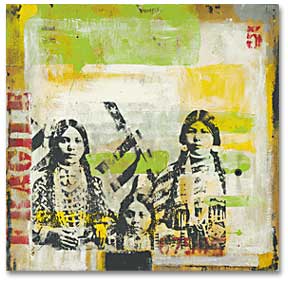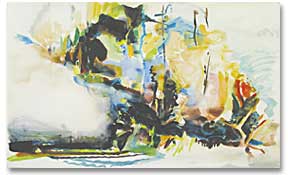|
COVER STORY | IN THE NEWS | MEDIA MAVEN | STAGE MATTERS | DIRT | ARTBEAT November 2, 2006About Cultural Experienceby KATHERINE ALMY
Right: "Santa Fe Landscape" series
painting Born in Santa Fe, Hyde grew up in central New York, then returned to New Mexico to study at the Santa Fe Fine Arts Institute and the Institute of American Indian Arts. He's been exhibiting his work for 14 years -- since he was 18 -- showing in many Santa Fe galleries as well as in Chicago, New York and San Francisco. Having established himself in the competitive Santa Fe art market, he felt comfortable moving away and keeping up his career there from a distance. He recently settled in Crescent City with his wife, Onna, and immediately set to work on making a name for himself on the North Coast. Looking around at galleries, he found Piante, and landed his first local show starting on Nov. 3, running through Nov. 29. I don't think Piante's owner, Sue Natzler, could
have found a better person to show with Hyde than Bob Bensen,
a native of Northern California who's been painting here for
over 30 years. In some ways, these two artists are as different
as they can be. They also have much in common. They are both
making art that expresses their experiences as Native Americans.
As Bensen said, and Hyde agreed, "It has t Bensen grew up on a ranch east of Willow Creek, near the Trinity River. He got his BA from Humboldt State, and after receiving his MFA from the University of Illinois in 1973, he returned to Humboldt County and has been teaching art at the College of the Redwoods ever since. Bensen is an enrolled member and Elder of the Tsnungwe Tribe of Trinity and Humboldt Counties. As an elder, he knows the tedious administrative work of dealing with government bureaucracies to get his tribe recognized and to secure land rights. That kind of work is necessary, but can numb the soul. Left: "Mad River Canyon" by Bob Benson. To heal the spirit, and to connect to his heritage, Bensen paints watercolors on site, and his work is that of someone deeply rooted to the land. He has the rare experience of knowing this place in his bones. Not only has he lived here all of his life, but so have his parents and his grandparents and his great-grandparents and their parents. He says, "My father's mother's family had lived in the nearby area going back before contact." I wonder sometimes what it's like when home has been home for hundreds (or thousands) of years. How does it affect your relationship to the world? And how do you live with it when the landscape that's been known and loved for generations starts to degrade in the relatively short time that the newcomers have been here? Bensen's connection to the land is coupled with impressive technical skill. Watercolor is a difficult medium, and he really has a handle on how to use it to its full potential. His paintings often have the rich color and texture associated with oils, but they still maintain the fluidity of watercolor. His approach involves seeking out places of deep meaning and power, allowing that power into his very being and expressing it with paint on paper. For the rest of us, the paintings become a tap on the shoulder to remind us of the sacredness of these places, of our intimate connection with our environment and the importance of protecting what we have. His work is an expression of his culture in that his people do not separate art from life, just as they do not separate themselves from the land. He is a part of the land, and the land speaks through him by way of his art. As he describes it, the paintings are a "visual renaming" of sacred places. In a sense, Bensen and Hyde are dealing with the same issues, although they go about it in different ways. Hyde has some landscape pieces in the show, but they are of an entirely different nature. There is a series of small panel paintings called "Santa Fe Landscape," but they're not the kind of Southwest sunset paintings you might be envisioning. With that sort of thing so overdone, Hyde wanted to get a different perspective on Santa Fe. Inspired by packing materials piled up behind the galleries of the city, he created an image of three Indian girls with "Fragile" stamped on the side and a barcode at the bottom to describe the way Native American culture is commodified and shipped in and out of New Mexico. Another piece shows a baby in a cradleboard with the stamp, "priority overnight." While Hyde may have a deep connection to a place, as Bensen does, this is not what he's talking about in his work -- at least not yet. He's still working out the anger and frustration of having everything -- land, language, culture -- taken away from his people. "I'm part of a culture that's a victim of rape, genocide and theft -- and it's still happening today," he says. There is humor in his work -- humor is an important part of his culture, he tells me -- but there are some difficult issues addressed, which inevitably leads to work that can be uncomfortable, shocking or upsetting. The most compelling reason for a show of this nature stems from that last part of Hyde's comment: "It's still happening today." That's something that most non-native Americans don't get. Native American art is not about the past -- and their struggle is not over. This is not a lamentation over what happened a long time ago, it's a cry for action today. These are people who are alive today demanding respect for a vital culture. It's impossible to completely understand someone else's culture, but we can see the art, listen to the stories, open our minds. We can appreciate, identify and respect.
Got a local exhibit or art event that might make a good story? Send your art news to [email protected] or write in care of the North Coast Journal, 145 South G Street, Suite A, Arcata, CA. 95521. COVER STORY | IN THE NEWS | MEDIA MAVEN | STAGE MATTERS | DIRT | ARTBEAT Comments? Write a letter! © Copyright 2006, North Coast Journal, Inc. |


 Frank Buffalo Hyde, a Southwestern artist who
traces his heritage to the Nez Perce and Onondaga people, has
been recognized for breaking through the boundaries that many
place around what they think Native American art should look
like. He is struggling to define himself as a Native American
without being seen as a stereotype. He is dealing with what he
calls the "fragmented contemporary life" of a Native
American U.S. citizen.
Frank Buffalo Hyde, a Southwestern artist who
traces his heritage to the Nez Perce and Onondaga people, has
been recognized for breaking through the boundaries that many
place around what they think Native American art should look
like. He is struggling to define himself as a Native American
without being seen as a stereotype. He is dealing with what he
calls the "fragmented contemporary life" of a Native
American U.S. citizen. o be about cultural experience."
o be about cultural experience."